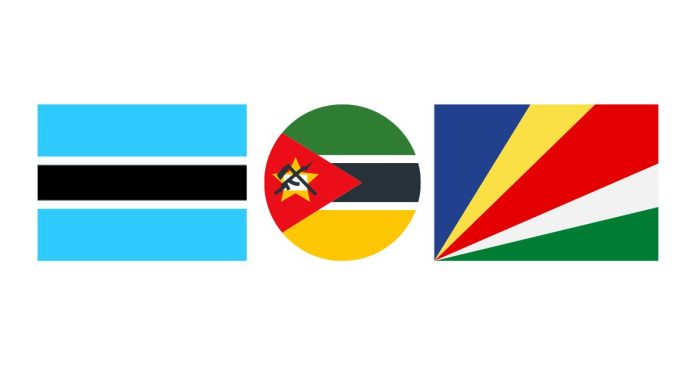Flags are powerful symbols that represent a country’s identity, culture, and history. While every national flag is unique, some color combinations are shared by multiple countries, creating fascinating parallels. One such combination is blue, white, and black—colors that evoke a sense of unity, strength, and pride. Estonia’s flag is perhaps the most famous example of this color trio, but it’s not the only one.
Let’s explore some other countries that feature blue, white, and black on their flags, and what these colors represent in their contexts.
1. Botswana
Botswana’s flag features a striking combination of blue, white, and black. The flag is made up of a light blue field with a black and white horizontal stripe in the center. The blue symbolizes the sky and water, essential elements in a country often affected by drought. The black and white stripes represent the people of Botswana—black symbolizing the country’s majority, and white representing the minority communities. The design is simple yet powerful, reflecting Botswana’s commitment to peace, unity, and harmony.
2. Seychelles
Seychelles, an island nation in the Indian Ocean, features a vibrant flag made up of five oblique bands in blue, white, black, yellow, and red. The blue represents the sky and the ocean, while the white signifies social justice and harmony. Black symbolizes the people of the nation, while the yellow band represents the country’s natural resources and future prosperity. Though not a dominant part of the design, the presence of blue, white, and black in the flag’s overall layout connects Seychelles to this color theme.
3. South Sudan
South Sudan’s flag features three horizontal stripes of black, red, and green with a blue triangle containing a white star. The black represents the people of South Sudan, the red symbolizes the bloodshed in the struggle for independence, and the green represents the land and natural resources. Blue is included in the flag’s triangle, signifying the Nile River, an important geographical feature of the country, while white symbolizes peace and harmony. The flag of South Sudan is a symbol of the country’s hard-won independence and its aspirations for unity and peace.
4. Malta
The flag of Malta is a simple but elegant design: a two-field flag with white on the hoist side and red on the fly side, with the George Cross emblazoned on the upper-left corner. The George Cross itself, awarded to Malta by King George VI for its bravery during World War II, features a combination of blue, white, and black. While Malta’s national flag does not use all three colors in its main design, the George Cross prominently incorporates the blue, white, and black scheme, making it a notable example.
5. Yemen
Yemen’s flag, composed of three horizontal stripes—red, white, and black—might not feature blue as its primary color, but it fits into the broader context of flags that include blue, white, and black in their overall symbolism. The red symbolizes the struggle for independence, the white represents a bright future, and the black stands for the country’s dark past under colonial rule. While Yemen’s flag doesn’t have the typical blue found in some of the other flags listed here, its use of black, white, and red reflects a significant historical and cultural meaning.
6. Jamaica (Independence Day Variation)
While Jamaica’s standard flag doesn’t feature blue, white, and black together, the country’s Independence Day flag design often incorporates these colors in its commemorative versions. The black represents the strength and creativity of the people, while the gold (a common feature) symbolizes wealth, and green stands for the country’s land and natural resources. Although this variation isn’t an official national flag, it is a notable use of these colors in certain celebrations.
7. Mozambique (Historical Context)
Mozambique’s flag features green, black, yellow, white, and red, with an image of an AK-47 rifle and a hoe in the middle. While blue doesn’t appear in the flag’s primary design, historically, the colors blue, white, and black were used in early iterations of Mozambique’s flag designs, reflecting the country’s struggle for independence and its diverse cultures. These flags are part of the rich tapestry of Mozambique’s revolutionary history.
Why Do These Countries Use Blue, White, and Black?
The use of blue, white, and black in flags is not a coincidence. These colors often symbolize important aspects of a country’s heritage or geography:
- Blue often represents the sky, water, or the sea, reflecting a country’s connection to nature, peace, or the aspirations of its people.
- White commonly symbolizes peace, unity, and harmony, or social justice and equality.
- Black is frequently used to represent the people of the country, especially in contexts where African heritage is prominent. It can also symbolize resilience, strength, or the struggles faced in history.
Each flag tells a story, and the use of these colors can carry different meanings depending on the country’s culture, history, and political journey.
While Estonia may be the most iconic example of a blue, white, and black flag, it’s clear that many countries around the world incorporate these colors in their flag designs to convey deeper messages about their people, history, and values. Whether it’s Botswana’s peaceful unity, South Sudan’s hope for the future, or the historical significance in flags like Malta’s George Cross, blue, white, and black continue to serve as powerful symbols in the global tapestry of national identities.
So, next time you look at a flag, take a moment to think about the colors and what they represent—not just on a national level, but as part of a larger global narrative.


